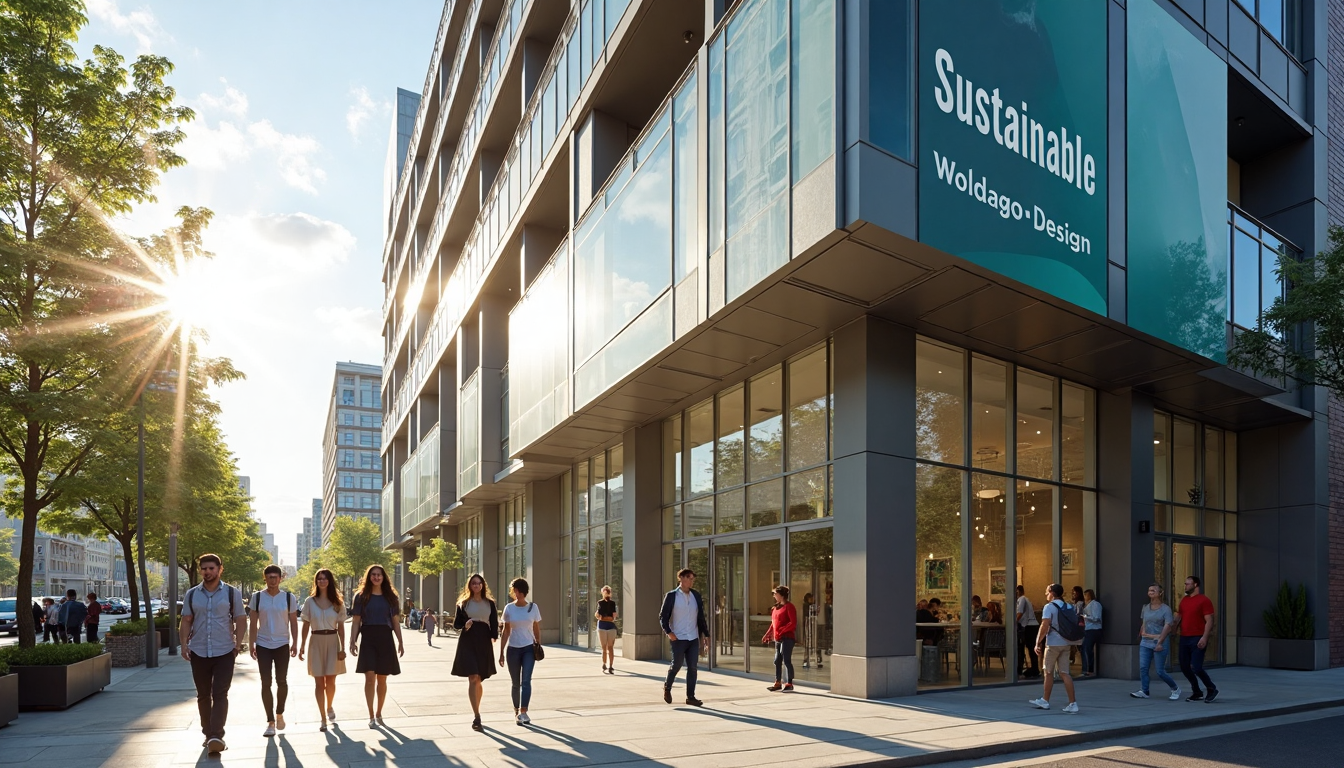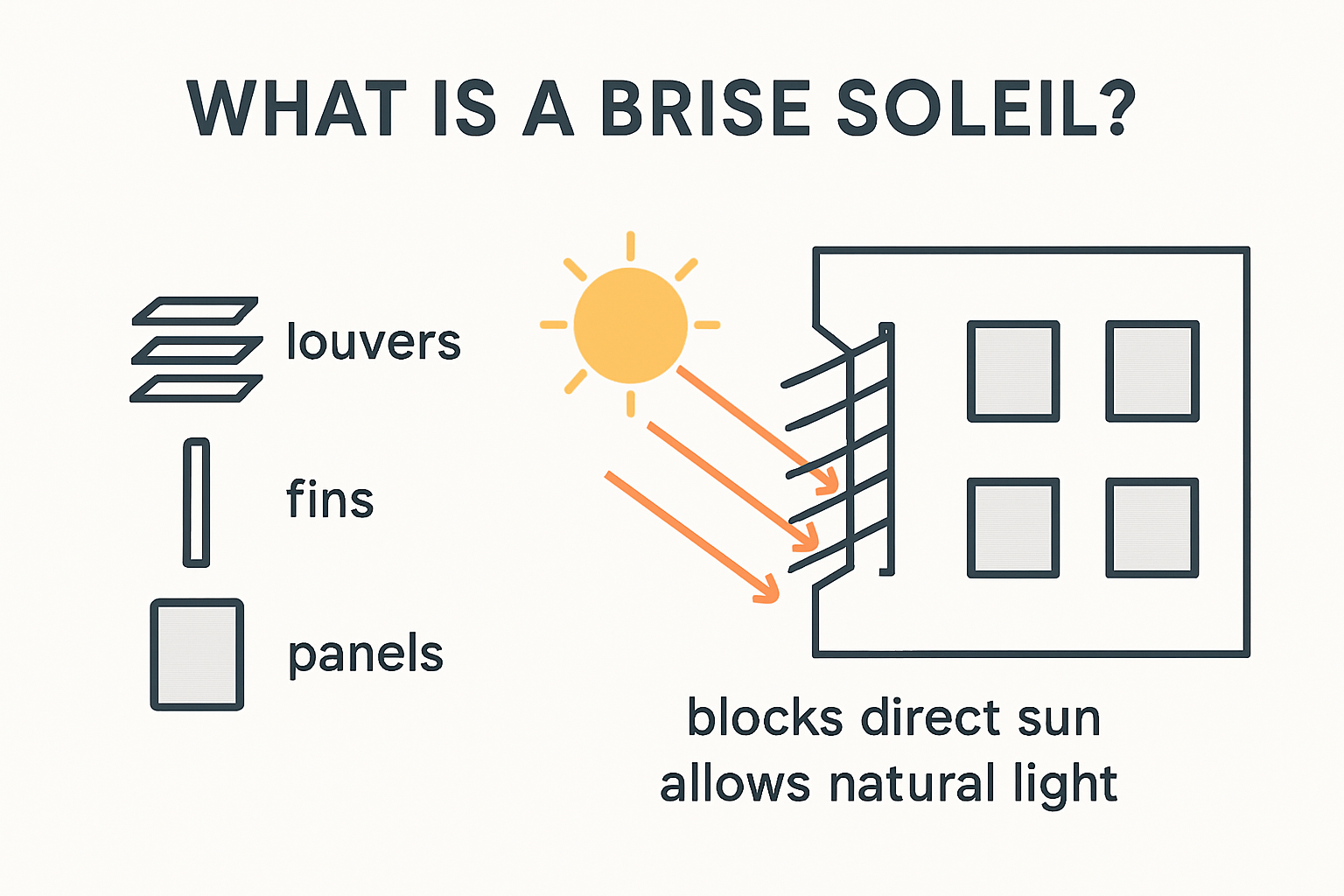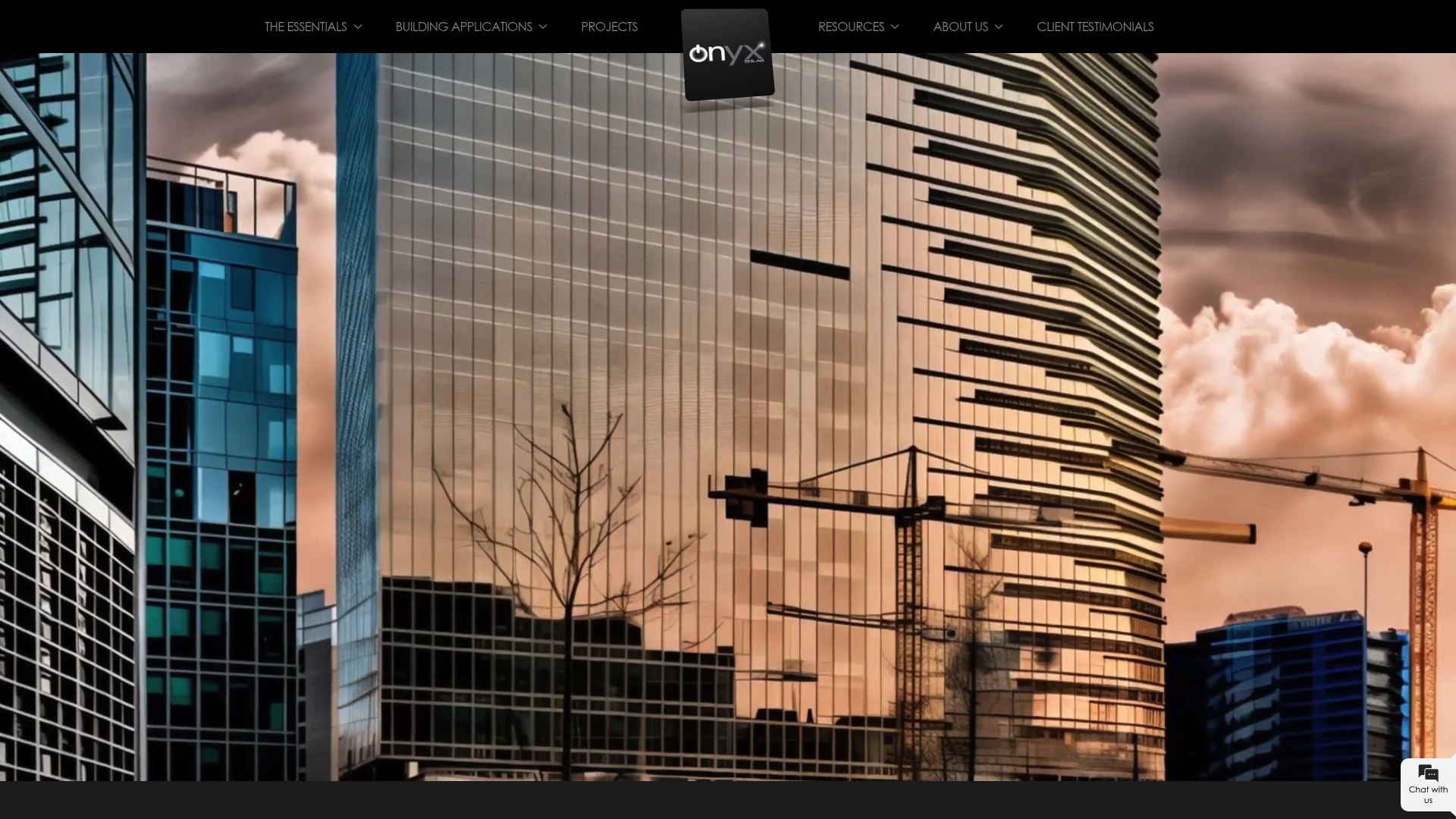
July 16, 2025
Onyx Solar USA
79 Madison Avenue, Ste. #231
New York, NY 10016
usa@onyxsolar.com
+1 917 261 4783
Onyx Solar Spain
Calle Río Cea 1, 46,
05004 Ávila. Spain.
info@onyxsolar.com
+34 920 21 00 50

Architects everywhere are pushing for smarter ways to keep buildings cool without guzzling energy. Here is a surprise: Brise soleil systems can cut summer cooling energy use by up to 31 percent just by shaping how sunlight hits the building. Yet most people think these sun shades are all about good looks and bold design. The real story is that they are quietly turning ordinary buildings into efficient, ultra-comfortable spaces—and even generating their own clean power.
| Takeaway | Explanation |
|---|---|
| Brise Soleil is Essential for Energy Efficiency | These systems can decrease cooling energy demand by 9% to 31%, significantly enhancing sustainable building design and operational efficiency. |
| Dynamic Solar Management is Key | Effective brise soleil designs use precise geometric calculations to block high-angle summer sun while allowing low-angle winter sunlight, ensuring optimal thermal regulation. |
| Integration of Advanced Technologies | Modern implementations incorporate features like photovoltaic elements, transforming shading devices into energy-generating components that enhance building performance. |
| Impact on Occupant Comfort | Brise soleil systems improve indoor environmental quality by reducing glare, stabilizing temperatures, and optimizing natural lighting, contributing to occupants’ well-being. |
| Aesthetic and Functional Synergy | These architectural elements serve not only practical solar management purposes but also add visual interest, embodying the intersection of design, technology, and sustainability. |
Brise soleil represents a sophisticated architectural solution that transforms how buildings interact with solar radiation. Originating from the French term meaning “sun breaker”, this innovative design element serves as a critical passive environmental control mechanism for modern sustainable architecture.

At its core, brise soleil is an architectural feature strategically designed to manage sunlight and heat entering a building. According to architectural research from the Journal of Civil Engineering and Architecture, these sophisticated sun-shading systems can reduce cooling energy demand by 9% to 31% during summer months, representing a significant advancement in energy-efficient building design.
The fundamental principle behind brise soleil involves creating physical barriers that deflect direct solar radiation while allowing diffused natural light to penetrate interior spaces. These systems typically incorporate horizontal or vertical fins, louvers, panels, or screens integrated directly into a building’s facade. By carefully calculating the angle, depth, and orientation of these elements, architects can optimize solar protection without completely eliminating natural illumination.
Brise soleil systems operate through several sophisticated mechanisms. Passive solar control becomes a primary function, where physical barriers interrupt and redirect solar radiation before it can generate excessive heat within interior environments. This approach differs fundamentally from traditional solar protection methods by providing a more dynamic and aesthetically integrated solution.
Research from sustainable architecture studies indicates that these systems can achieve multiple performance objectives simultaneously:
The effectiveness of brise soleil depends on precise geometric calculations considering factors like building latitude, solar angle, orientation, and local climate conditions. Architects and engineers must collaborate to design systems that respond specifically to each unique architectural context.
Modern brise soleil implementations increasingly incorporate advanced materials and technologies. Some contemporary designs integrate photovoltaic elements, transforming sun-shading surfaces into energy-generating components. This evolution represents a significant step toward multifunctional architectural solutions that simultaneously manage environmental conditions and generate renewable energy.
Understanding brise soleil requires recognizing it as more than a simple architectural accessory. It is a sophisticated environmental control strategy that embodies the intersection of design, physics, and sustainability. By reimagining how buildings interact with solar radiation, architects can create spaces that are not just sheltered, but intelligently responsive to their environmental context.
To help clarify the key mechanisms and benefits of brise soleil systems described above, the following table summarizes their main functions and related advantages:
| Function | Description | Benefits |
|---|---|---|
| Passive Solar Control | Physical barriers block/redirect solar radiation | Minimizes indoor heat gain, reduces cooling demand |
| Thermal Regulation | Reduces solar heat penetration and temperature fluctuations | Maintains stable indoor temperatures |
| Glare Reduction | Controls light intensity entering interior spaces | Improves visual comfort, reduces eye strain |
| Energy Efficiency | Decreases reliance on air conditioning and mechanical systems | Lowers energy consumption and operational costs |
| Aesthetic Enhancement | Adds depth, texture, and interest to building facades | Enhances architectural appeal while serving functional roles |
| Advanced Technologies | Integration of photovoltaic and adaptive materials | Enables renewable energy generation from shading surfaces |
Designing modern buildings with advanced solar management requires a holistic approach that integrates architectural aesthetics, environmental performance, and technological innovation. Sustainable building design has evolved far beyond traditional construction methods, demanding sophisticated strategies for managing solar radiation and thermal dynamics.
Architectural design of brise soleil systems demands meticulous geometric calculations. According to research from Britannica, these systems are engineered to strategically block high-angle summer sun while permitting low-angle winter sunlight, creating a dynamic solar management solution. This nuanced approach requires understanding complex solar trajectories, building orientation, and local geographic conditions.
The most effective brise soleil designs incorporate precise angular calculations that respond to specific environmental contexts. Architects must consider factors such as latitude, seasonal solar angles, building height, and surrounding urban environment. By developing mathematically derived shading elements, designers can create intelligent facades that adapt to changing solar conditions throughout the year.

Modern brise soleil systems increasingly merge architectural design with advanced technological capabilities. A groundbreaking example from the Milwaukee Art Museum demonstrates how architectural elements can transcend traditional static design. Their brise soleil, inspired by bird wings, dynamically opens to a 66-meter wingspan during the day and closes during adverse weather conditions, representing a revolutionary approach to adaptive architectural design.
Contemporary implementations often integrate multiple performance objectives:
Innovative architects are transforming brise soleil from passive architectural elements into active environmental management systems. Learn more about emerging solar design technologies that are reshaping our understanding of building envelopes.
The ultimate goal of modern brise soleil design transcends simple solar protection. These systems represent a sophisticated intersection of environmental science, architectural creativity, and technological innovation. By reimagining how buildings interact with solar energy, architects can create structures that are not just shelters, but intelligent, responsive environmental interfaces that actively contribute to sustainability and human comfort.
Brise soleil systems represent a sophisticated approach to enhancing building performance, delivering multifaceted benefits that extend far beyond traditional architectural solutions. Energy optimization becomes a critical outcome of these intelligent solar management strategies, transforming how buildings interact with environmental conditions.
Research from environmental engineering studies indicates that brise soleil systems can decrease a building’s cooling load by approximately 30%, representing a significant advancement in sustainable design. External shading devices like brise soleil intercept solar radiation before it penetrates the building envelope, creating a highly effective thermal barrier that minimizes heat gain and reduces mechanical cooling requirements.
The strategic design of these systems allows for precise solar radiation management. By carefully calculating angle, depth, and orientation, architects can create passive cooling mechanisms that dramatically reduce energy consumption. This approach transforms building facades from passive surfaces into active environmental control systems that intelligently respond to changing solar conditions throughout the day and across seasonal variations.
According to architectural comfort research, brise soleil systems significantly enhance indoor environmental quality by mitigating several critical comfort factors:
Beyond energy efficiency, these systems contribute to improved psychological and physiological well-being for building occupants. By creating more stable and comfortable interior environments, brise soleil supports enhanced productivity, reduced eye strain, and a more pleasant spatial experience.
Explore advanced solar management techniques that can further optimize building performance and occupant comfort.
The true value of brise soleil lies in its holistic approach to building design. These systems represent more than technical solutions they are sophisticated environmental interfaces that balance aesthetic expression, energy efficiency, and human comfort. By reimagining how buildings interact with solar energy, architects can create spaces that are not just shelters, but intelligent, responsive environments that actively contribute to occupant well-being and sustainable development.
To further clarify the diverse benefits of brise soleil for both building performance and occupant comfort, the table below summarizes key outcomes discussed in this section:
| Benefit Area | Specific Contributions | Impact on Building/Occupants |
|---|---|---|
| Cooling Load | Reduces summer energy use by 9% to 31% | Lowers operational costs, promotes energy efficiency |
| Glare Reduction | Controls direct sunlight intensity | Enhances visual comfort, minimizes eye strain |
| Temperature Control | Maintains stable interior temperatures | Improves comfort and reduces HVAC dependence |
| Natural Lighting | Optimizes daylight penetration and diffusion | Supports healthy circadian rhythms, boosts productivity |
| Energy Generation | Integrates photovoltaics into shading elements | Provides renewable electricity, further boosts savings |
| Psychological Well-being | Creates visually pleasing and comfortable spaces | Improves satisfaction, mood, and overall well-being |
As sustainable architecture continues to evolve, brise soleil systems are emerging as transformative solutions that redefine how buildings interact with environmental conditions. Innovative architectural applications are pushing the boundaries of solar management, creating intelligent structures that are both aesthetically compelling and environmentally responsive.
Research from architectural studies highlights the historical significance of brise soleil, tracing its roots to pioneering designs like Le Corbusier’s Ministry of Education in Rio de Janeiro. These early implementations demonstrated how strategic solar shading could dramatically improve indoor comfort in challenging tropical climates.
Contemporary applications are taking these principles to extraordinary levels. The ENERPOS building in Réunion Island represents a breakthrough in bioclimatic design, utilizing brise soleil systems to achieve net-zero energy status. By integrating natural ventilation and sophisticated shading strategies, such projects showcase the potential of intelligent architectural solutions to address complex environmental challenges.
According to a comprehensive study in civil engineering, recent implementations in residential neighborhoods like Baošići, Montenegro, demonstrate remarkable energy performance. These systems can reduce cooling energy demand by 9% to 31% during summer months, representing a significant leap in sustainable building design.
Modern brise soleil applications are characterized by their adaptive and multifunctional nature:
Discover innovative photovoltaic technologies that are revolutionizing architectural solar management.
The most exciting developments lie in the convergence of architectural design, environmental science, and advanced technologies. Brise soleil is no longer just a passive architectural element but an active, intelligent interface that responds dynamically to environmental conditions. These systems represent a profound reimagining of building envelopes as living, breathing entities that actively contribute to sustainability, energy efficiency, and human comfort.
As we move further into 2025, brise soleil applications continue to challenge our understanding of architectural possibilities. They demonstrate that sustainable design is not about compromise, but about creating more intelligent, responsive, and beautiful built environments that harmonize with their natural surroundings.
A brise soleil, meaning “sun breaker” in French, is an architectural feature designed to control sunlight and heat entering a building, enhancing energy efficiency and occupant comfort.
Brise soleil systems can reduce a building’s cooling energy demand by 9% to 31% during summer months by blocking direct solar radiation while allowing diffused natural light to enter interior spaces.
Brise soleil systems not only improve energy efficiency but also enhance occupant comfort by reducing glare, stabilizing temperatures, and optimizing natural lighting, thus fostering a better indoor environment.
Yes, modern brise soleil designs can integrate photovoltaic elements, allowing them to generate renewable energy while providing solar shading, effectively transforming them into energy-generating components.
Is your project facing the challenge of rising energy costs and demanding net-zero standards highlighted in our guide to brise soleil? Imagine solving those pain points with a solution that provides both smart solar shading and generates on-site renewable power. Brise soleil systems deliver outstanding comfort and efficiency, but with the right partner, they can also make your building a source of clean energy. That is where Onyx Solar comes in. Our proven photovoltaic glass solutions are designed to integrate seamlessly into brise soleils, facades, and other architectural elements discussed in the article.

Ready to transform your design into a high-performance, energy-generating space? Explore how real-world projects around the globe have applied our technology by visiting our case studies. Or, if you want to move to net-zero and discover how our award-winning solutions fit your next project, connect with the experts at Onyx Solar today. Do not miss the chance to turn your building into a true innovation in sustainable architecture.
Over 500 projects completed across 60 countries on all five continents.
Learn how our photovoltaic solutions are shaping the future of architecture.
Explore our full catalogue available in PDF or as an AUDIOBOOK.